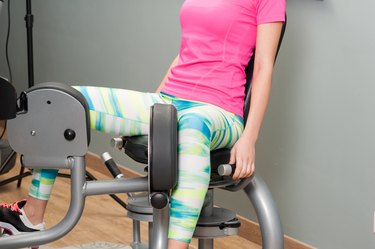
The muscles on your inner thighs swing your legs in, toward the midline of your body. Training these muscles can improve your athletic performance and decrease your risk of injury. The best inner thigh exercise equipment will allow you to duplicate that "inward" leg motion against resistance.
Inner Thigh Toning Exercises
Video of the Day
When people discuss working your inner thigh muscles, they usually mean the adductor longus, adductor magnus, adductor brevis, and perhaps also the pectineus and gracilis, as identified at ExRx.net. This cluster of muscles in your inner thighs is primarily responsible for the motion of hip adduction, or bringing your legs in toward the midline of your body.
Video of the Day
Like most muscle groups in your body, you can work your inner thighs with a variety of equipment. Some of the most effective and convenient options include gravity (for those just starting out), ankle weights, stability balls, a low cable pulley or elastic resistance band, and a specialized inner thigh workout machine available in some gyms.
Read more: Fastest Way to Heal Inner Leg Muscles
Move 1: Side-Lying Hip Adduction
- Lie on your side. Bend your upper leg and plant that foot in front of your body, wherever it's most comfortable. Your hips and shoulders should be vertically stacked, and your lower leg should remain straight.
- Lift your lower leg as far as it'll comfortably go without "flinging" it; this exercise has a fairly small range of motion.
- Return your lower leg to the starting position with a controlled motion. Keep your inner thigh muscles under mild tension, even at the bottom of the movement.
- Repeat on the other leg.
It's difficult to add extra resistance from this position. The most practical method is using an ankle weight.
Tip
In an EMG study (electromyography) of 24 college students, published in the May 2014 issue of the Journal of Sport Rehabilitation, this exercise was compared with five other common inner thigh exercises and found to produce the most activity in your adductor longus.
Move 2: Ball Squeezes
- Stand with your legs straight but not locked, and place a small stability ball between your knees.
- Squeeze your legs inward against the ball.
- Relax your legs enough to let them spread apart, but not so much that you lose tension on the ball.
In the aforementioned Journal of Sport Rehabilitation study, this exercise produced the second-most activation in the adductor longus. For barre, Pilates and rehabilitative settings, you might also do this using a small, soft playground ball and from a variety of body positions.
Move 3: Inner Thigh Workout Machine
Most gyms have some variety of hip adductor machine — and although it doesn't typically pop up in clinical studies of inner thigh muscle activity, this type of inner thigh workout at the gym is tops in convenience.
- Sit in the machine, legs against the inner thigh pads. Squeeze your core to keep your back from arching as you spread your legs to a comfortable starting position.
- Adjust the machine's range of motion, if possible, so there is mild tension on your inner thigh muscles at the starting position.
- Squeeze your legs inward against the machine's resistance.
- Return to the starting position with a smooth, controlled movement. Keep your abs tight throughout, and do not use the weight to stretch your legs apart — save the inner thigh stretches for after your workout.
Move 4: Standing Cable Hip Adduction
- Adjust a cable pulley to a low position and attach an ankle cuff.
- Place the ankle cuff around your right leg, then stand with your right side toward the low pulley.
- Step away from the pulley until you feel mild tension in the cable, then stand square with your feet about hip-width apart. Shift your weight onto your left leg.
- Focus on keeping your hips and torso stable as you bring your right leg in toward your midline. Allow it to cross slightly in front of your left leg.
- Once you've done a full set on one side, switch the ankle cuff to your other leg.
You can also do this exercise using an elastic resistance band, with one end anchored at about ankle height and a loop or ankle cuff in the other end.
Tip
For a longer range of motion, you can start with your cuffed leg lifted slightly off the ground — which means stepping a little farther away from the pulley to start — as demonstrated by the American Council on Exercise. If you choose to do this, focus on keeping your hips and core stable and using a smooth, controlled range of motion.
Read more: 7 Dynamic Stretches to Improve Hip Mobility
Was this article helpful?
150 Characters Max
0/150
Thank you for sharing!
Thank you for your feedback!